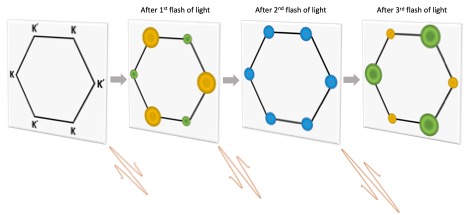| Apr 23, 2023 |
Valley-transistor in two-dimensional materials - an ingredient for all-optical quantum technologies
(Nanowerk News) Researchers from the Indian Institute of Technology Bombay have devised a novel method to construct valley transistors in two-dimensional materials using brief light pulses, bringing us closer to realizing practical all-optical quantum technologies.
|
|
Transistors, essential components in electronics, control the flow of electric current and switch it on and off as needed. These on-off states represent the binary units, or bits, that enable conventional computers to function. Nanotechnology has advanced electronic devices by miniaturizing them and enhancing their performance. Graphene, an atomically thin material with a hexagonal carbon atom structure, is a leading example of nanotechnology's potential.
|
|
Scientists have synthesized other two-dimensional materials inspired by graphene, which have the potential to revolutionize emerging quantum technologies. Electrons in these materials possess an additional property called valley pseudospin, which is associated with local energy minima. These materials exhibit two valleys that can be viewed as binary units, like 0 and 1, and their superpositions, which are crucial for quantum technologies.
|
|
These valleys can be harnessed to encode, process, and store quantum information at room temperature, enabling secure encryption and novel computational methods that are impossible with conventional computers. Moreover, quantum technologies offer simulation tools that facilitate the development of innovative materials and pharmaceuticals.
|
 |
| Illustration of the valley transistor in two-dimensional materials. (Image courtesy of the researchers)
|
|
The realization of valley transistors at room temperature is essential for practical quantum technologies. A valley transistor is a switch that allows for valley-selective operations to be toggled between valleys as needed. However, short valley lifetimes pose a significant challenge for creating valley transistors.
|
|
A recent publication in Physical Review Applied ("All-Optical Ultrafast Valley Switching in Two-Dimensional Materials") offers a solution to this issue. Researchers Navdeep Rana and Gopal Dixit have developed a method for creating valley transistors in two-dimensional materials using a series of three brief light pulses to control valley operations.
|
|
The researchers demonstrated that their control protocol is robust and universal, as they observed a valley transistor in both graphene and molybdenum disulfide, another two-dimensional material.
|
|
This work surpasses the current valleytronics paradigm and introduces the possibility of valley transistors operating at petahertz (PHz) rates, significantly exceeding contemporary computational speeds.
|
|
According to Prof. Gopal Dixit, "With the availability of valley transistors in 2D materials, miniaturized quantum computers operating at room temperature, just like ordinary computers, could be a reality in the near future."
|

